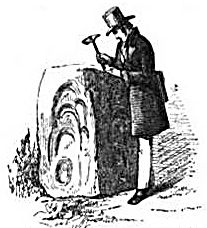Warington Wilkinson Smyth facts for kids
Sir Warington Wilkinson Smyth (born August 26, 1817 – died June 19, 1890) was an important British geologist. Geologists are scientists who study the Earth, including its rocks, minerals, and how it was formed.
About Warington Smyth
Warington Smyth was born in Naples, Italy. His father, Admiral W. H. Smyth, was working on a map of the Mediterranean Sea for the navy at the time.
Smyth went to school at Westminster School and Bedford School in England. Later, he studied at Trinity College, Cambridge. He was even part of the Cambridge rowing team in the famous 1839 Boat Race!
After college, he won a special scholarship that allowed him to travel for more than four years. He explored parts of Europe, Asia Minor (which is now Turkey), Syria, and Egypt. During his travels, he paid close attention to mineralogy (the study of minerals) and mining. He looked at places where coal was found, mines for metals, and salt mines. He also met many famous geologists and mineralogists.
In 1864, Smyth married Anna Maria Antonia Maskelyne. They had two sons who also became well-known. One son, Herbert Warington Smyth, became a mining engineer and traveler. Another son, Sir Nevill Maskelyne Smyth, was a soldier who won a very brave award called the Victoria Cross.
Warington Smyth passed away in his home in London in 1890. He was buried in St Erth, a village close to his country home in Cornwall. There is a special plaque in Truro Cathedral that remembers him, as he helped to build the cathedral.
Smyth's Work in Geology

When Smyth returned to England in 1844, he got a job as a mining geologist with the British Geological Survey. This organization studies the geology of Britain. In 1851, he also started teaching at the Royal School of Mines. He taught there for many years, first about minerals and then about mining.
Later in his career, he became the chief inspector for minerals for the government. He also worked for the Duchy of Cornwall, which is a special estate belonging to the British royal family.
One of his important studies was at the Roman gold mine called Dolaucothi. He wrote a paper about what he found there in 1846. Because of the gold rushes happening in California and Australia in the 1850s, he also gave many talks about gold mining.
In 1858, Smyth became a member of the Royal Society, which is a very old and respected group of scientists. He was also the president of the Geological Society of London from 1866 to 1868. In 1879, he led a special group that looked into accidents in coal mines. This important work continued until 1886.
Smyth wrote many papers for scientific journals. He also wrote two books: A Year with the Turks (1854) and A Treatise on Coal and Coal-mining (1867). In 1887, he was made a knight, which means he received the title "Sir" for his important contributions.
See also
- Dolaucothi
- Gold mining
- History of geology
- List of Cambridge University Boat Race crews


